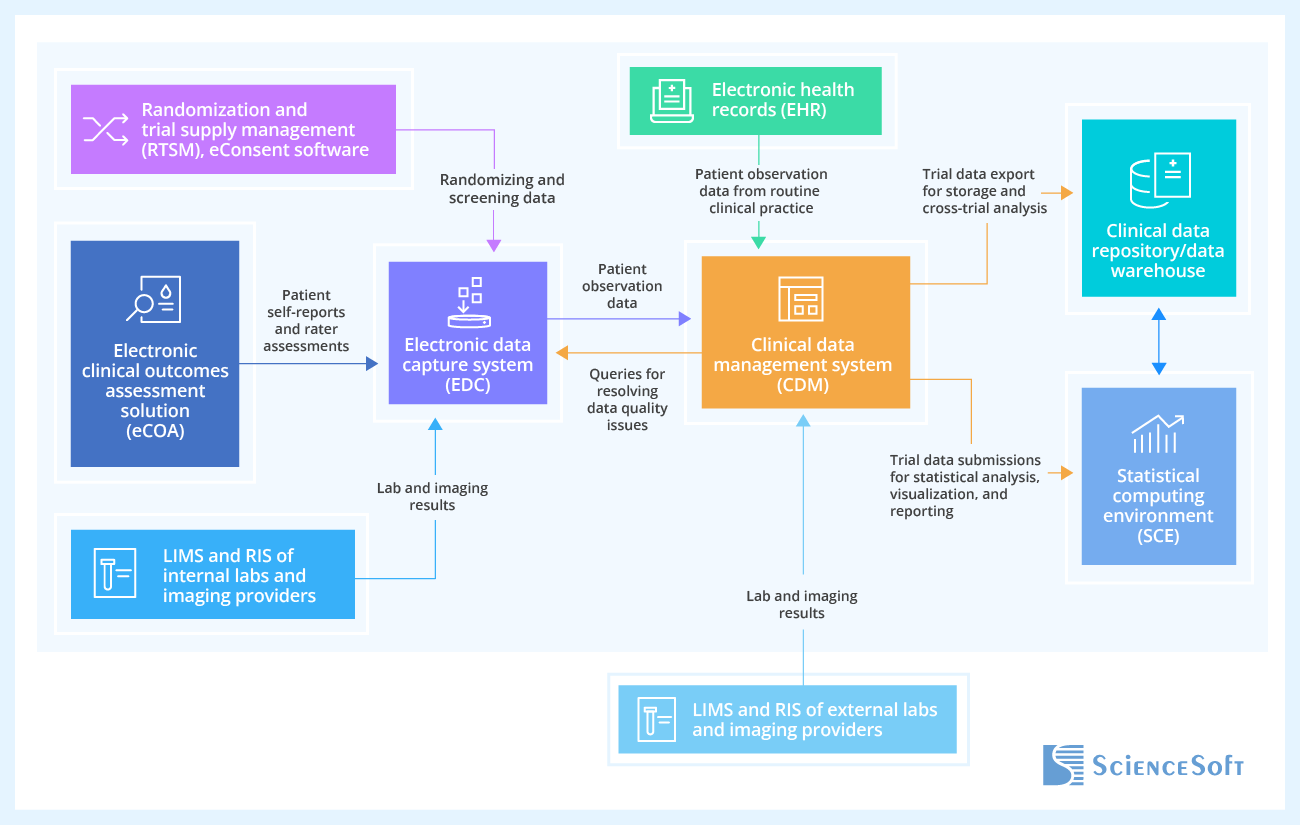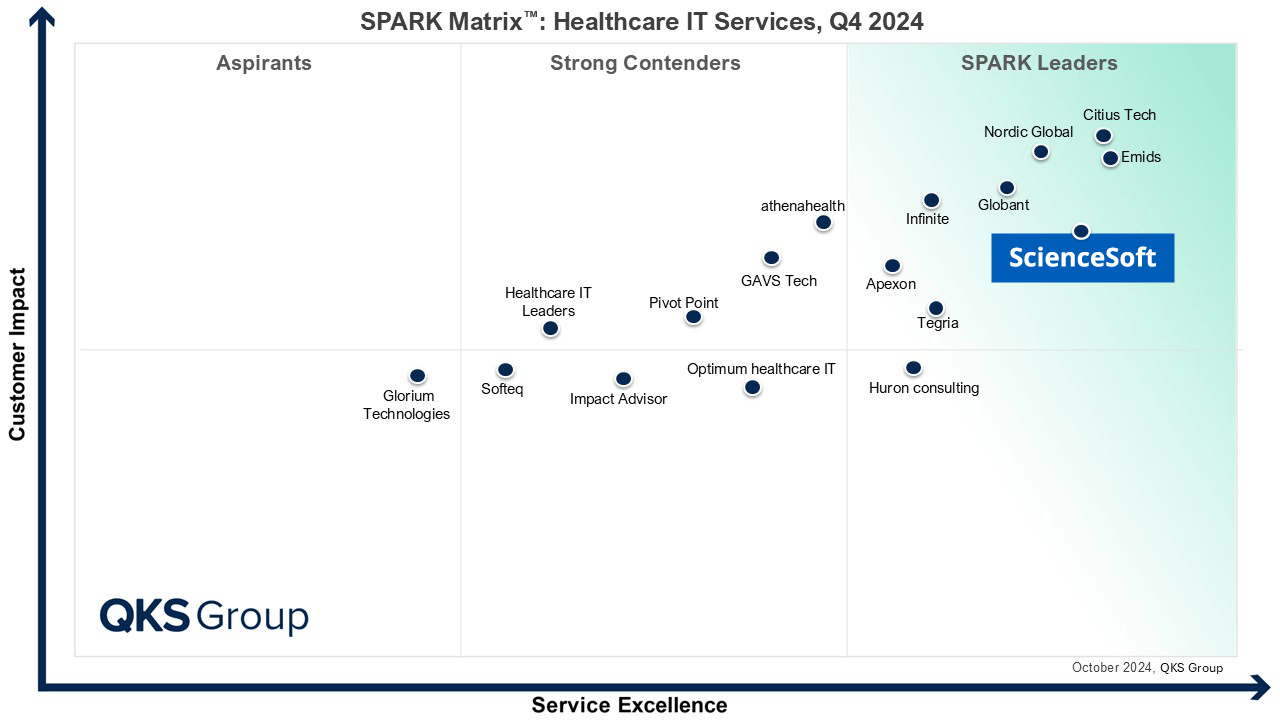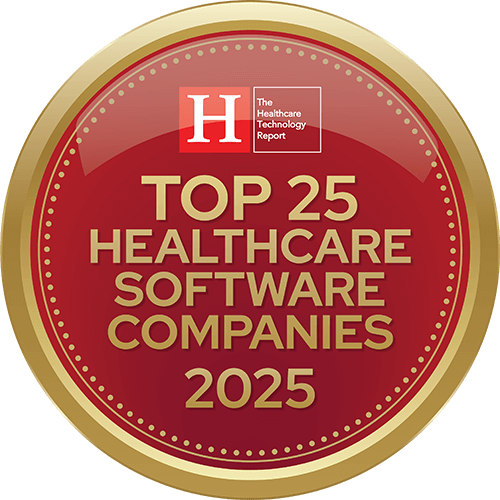Clinical Data Management (CDM) System
Features, Development Roadmap, Costs
In healthcare IT since 2005, ScienceSoft engineers compliant clinical trial management solutions that automate unique data management workflows, provide advanced analytics, and seamlessly integrate with internal systems and software of external vendors, including labs and medical imaging service providers.
Clinical Data Management (CDM) System at a Glance
A clinical data management system is used in life science R&D to consolidate the collected trial data, clean it from errors and inconsistencies, and transform it into research datasets ready for statistical processing. Sometimes, CDM systems include an electronic data capture (EDC) module aimed at collecting patient observation data (patient- or clinician-reported treatment outcomes from eCOA forms, eCRFs with visit data, lab and imaging results, readings from sensors and wearables, etc.). However, in most research organizations, CDM and EDC are separate systems.
The demand for advanced CDM software increases as research calls for richer evidence and the integration of more data sources. In a recent survey, 93% of 149 sponsors stated that their clinical data review, integration, and analysis pipelines are still excessively manual, time-consuming, and labor-intensive.
Custom CDM system development is the preferred choice for research organizations and pharmaceutical companies in the following scenarios:
- The need to import data from multiple external sources (such as specialty labs or radiology services).
- Out-of-the-box CDM solutions can be difficult or even impossible to integrate with existing custom software, especially legacy systems, such as EDC.
- The research organization needs unique data analytics capabilities to accelerate research, gain data quality insights, and address critical data quality risks.
Implementation time: 6 to 24+ months.
Essential integrations for a CDM system: an electronic data capture (EDC) system, clinical data repository (CDR) or data warehouse, statistical computing environment (SCE) system, and software of external laboratories or medical imaging services providers.
Costs: $120,000–$900,000+, depending on complexity. Use our free calculator to estimate the cost of your project.
Core Features of a Clinical Data Management (CDM) System
The main goal of CDM solutions is achieving faster research cycle times through automation and increased staff efficiency, as well as the use of advanced analytics, including AI-powered data analysis. Below is an overview of the CDM features addressing most of the needs of ScienceSoft’s clients in life science R&D. In practice, each solution has a unique feature set, based on the requirements and priorities of each clinical research organization.
Raw data ingestion and standardization
- Ingesting trial data from diverse sources (EDC, lab and imaging providers, etc.).
- Data anonymization.
- Automatic inspection of incoming data for invalid, missing, or out-of-range values and discrepancies across different sources.
- The option to manually reconcile issues with incoming data (resolving import issues flagged by automated algorithm).
- Automatic standardization of incoming data (e.g., unifying units of measurement, date formats).
- Automated data coding with MedDRA for adverse events, WHODrug or RxNorm for medications, ICD-10 or SNOMED CT for diagnoses, LOINC for lab results, etc.
- Automatic loading of processed data into a clinical data repository (e.g., data warehouse).
Data cleaning tools
- A library of pre-configured data check rules.
- No-code builder for custom data check rules.
- ML/AI-powered detection of errors, inconsistencies, and anomalies in patient records, such as:
- Errors and discrepancies (wrong dosage, concomitant medication inconsistency across hospital visits, etc.).
- Abnormal changes in patient condition (e.g., sudden shifts in lab results between visits).
- Patient profiles with data distributions deviating from the overall cohort.
- Inconsistencies across listings (e.g., across adverse events, medical history, and concomitant medication datasets).
Trial data reviewing
- Unified data manager workplace with access to listings, patient profiles, source patient data, exception reports, and query tracker.
- Collaborative clinical data reviewing and commenting.
- Automated change tracker flagging new or modified data for review.
- Automated approval workflows forwarding data for review based on user roles.
- Customizable exception reports highlighting active issues, queries, and changes made since the last review.
- Data locking upon review completion.
Query management
- Creating EDC queries and assigning them to specific individuals or user roles for resolution.
- Sending queries to external partners (e.g., to labs via email) directly from the CDM system.
- Automated query generation, prioritization (e.g., for long outstanding issues), and closure.
- Query tracking by priority, patient, assignee, due date, site, data domain, etc.
- Automated query approval, escalation, and resolution workflow.
Clean patient tracker
- Patient profiles with all aggregated observation data for each patient (eCRF and eCOA data, wearables output, lab results, X-rays, etc.).
- Dashboards with visualized patient condition and treatment data.
- Access to patient records stored in the EDC or any other integrated source system directly from the patient tracker.
- Tracking data cleaning progress and data readiness status.
Analytics and reporting
- Real-time tracking of data processing progress and readiness status for individual patients, patient groups, countries, and sites.
- Creation of scheduled and ad-hoc reports (e.g., data quality reports, coding status reports).
- A library of report templates.
No- or low-code listing builder
- Drag-and-drop expression builder for creating and editing listings and other curated datasets.
- Pre-built listing templates and the ability to reuse custom listings as templates.
- Pre-built functions for calculating derived values (e.g., complication risk scores) and the ability to create and save custom functions.
Data export
- Exporting clean data packages in a predefined format, either on-demand or on an automated schedule.
- Exporting data in bulk.
- Support for different formats (CSV, PDF etc.).
- Saving data as SAS/SPSS datasets.
- Data exchange according to HL7, FHIR, and DICOM standards with USCDI compliance for core clinical data; adherence to CDISC data interchange standards.
Risk-based quality management (RBQM)
- Configuring key risk indicators (KRIs) and quality tolerance limits (QTLs) for site performance and trial quality.
- Dashboards for monitoring KRIs, QTLs, and associated site, country, and study-level risks.
- AI-powered risk analysis to identify potential site performance, compliance, or data quality issues.
Compliance, security, and data privacy
- Role-based access controls (user authentication, access rights, action permissions, automatic logoff, etc.).
- Granular data access (e.g., for individual reports, specific fields).
- Multi-factor authentication (MFA).
- End-to-end data encryption at rest and in transit.
- Audit logs for all user and system actions, detailing changes made, the responsible party, and timestamps.
- Compliance with FDA 21 CFR Part 11, ICH E6(R2) GCP, and Cures Act requirements, HIPAA, HITECH, GDPR, ISO 14155:2020, and other applicable regulations.
Possible Integrations for a Clinical Data Management System

Electronic data capture (EDC) system — for automated data transfer from eCRFs to patient profiles in the CDM; for submitting data clarification queries to site staff and obtaining their replies.
External laboratories and medical imaging services — to automate the import of reports with patient examination results.
Clinical data repository (CDR) or data warehouse (DWH) — for exporting trial data to a centralized repository for storage, sponsor or CRO review, and use by other research teams.
Statistical computing environment (SCE) system — to send cleaned trial data for further statistical analysis, visualization, and reporting to regulatory bodies.
Key Steps for Developing Custom Clinical Data Management System Software
Below, ScienceSoft's experts provide a high-level overview of the typical roadmap for developing a CDM system.
Requirement engineering
Consultants and business analysts conduct interviews with a research organization’s stakeholders, including target users of the solution (trial data managers, medical reviewers, and site staff), to define the requirements for data consolidation, cleaning, analytics, and other capabilities of CDM software. At this stage, it’s essential to define the expected number of data sources, the format of incoming data from external vendors (e.g., biomarker or specialty labs), and the systems to be integrated with the CDM. Based on this information, the software requirements specification (SRS) is drawn up.
Besides key functional and performance capabilities, SRS outlines the security and compliance features. The compliance requirements for the software are usually based on FDA 21 CFR Part 11, ICH E6(R2) GCP, HIPAA, HITECH, GDPR, ISO 14155:2020, and other applicable standards and regulations.
Software design
At this stage, software architects define the necessary components of the CDM architecture, decide on the optimal integration methods, and choose tools and technologies for developing the solution. This stage includes choosing methods for clinical data integration, standardizing its formats, synchronizing in real-time, tracking its changes, and handling backups and exports. Collaborating with compliance consultants, the architects also design security measures.
UX and UI design
UX and UI designers map out the workflows and create interfaces tailored to the needs of specific user roles. For instance, data managers may need a convenient patient tracker with rich data visualization and the ability to access unresolved tasks for each specific site, patient, and patient group.
For each user role, designers carefully plan dashboards and interfaces so that the primary tools are easily available while secondary tools are kept aside to reduce UI clutter and enhance navigation.
Development and quality assurance
Developers code the back and front end of the CDM system according to the software requirements specification and UX/UI layouts and designs. Typically, the features are developed in iterations. After every iteration, the finished functionality is demonstrated to future users, who can try it out and provide feedback to help improve the solution in future iterations. For example, developers will need professional medical reviewers’ opinions on how to improve the automated data issue recognition and query generation system.
Every iteration typically includes the testing of the newly developed and already existing functionality. For a CDM system, integration testing is crucial to confirm that trial data retains its integrity when transferred to the data warehouse and EDC despite constant updates by multiple users. Security testing is carried out before major releases and the solution launch to ensure software compliance with data privacy and integrity regulations.
Deployment and support
After the launch, the development team supports the research staff in adopting the new CDM system by providing user manuals and offering consultations. For large-scale projects, a help desk is established to quickly address user requests and resolve problems. Experts also provide ongoing support for the software, keep track of its performance, and adjust it if necessary.
How Much Does It Cost to Develop a Custom Clinical Data Management System?
Based on ScienceSoft’s experience in healthcare software development, the costs of creating a clinical data management (CDM) system range from $120,000 to over $900,000. The costs are primarily driven by the number of data sources and the need for AI-supported automation, data issue detection, visualization, and analytics.
The table below provides an overview of the typical features found in basic, standard, and advanced CDM solutions, along with their estimated implementation costs.
Basic
Main capabilities:
- Data ingestion from EDC.
- Aggregated patient data view.
- Query tracking.
- Change tracking.
- Automated workflow for role-based review task assignment.
From $120,000
Standard
In addition to the capabilities of the basic system:
- Trial data management automation.
- Query management automation.
- Automated data export to the clinical data repository/DWH and statistical computing environment.
From $300,000
Learn the cost of your CDM system
ScienceSoft's experts are ready to provide a quote for your specific case.
Why Choose ScienceSoft for Your CDM Initiative
- Since 2005 in healthcare IT; 150+ successful projects in the domain.
- Experience in meeting GCP, FDA, HIPAA, HITECH, and GDPR requirements.
- Proficiency in healthcare data exchange standards such as HL7, FHIR, DICOM, and more.
- ISO 13485- and ISO 9001-certified quality management, ISO 27001-certified information security management.
Our awards and partnerships

Featured among Healthcare IT Services Leaders in the 2022 and 2024 SPARK Matrix
Recognized for Healthcare Technology Leadership by Frost & Sullivan in 2023 and 2025
Named among America’s Fastest-Growing Companies by Financial Times, 4 years in a row

Top Healthcare IT Developer and Advisor by Black Book™ survey 2023
Recognized by Health Tech Newspaper awards for the third time (2022, 2023, 2025)

Named to The Healthcare Technology Report’s Top 25 Healthcare Software Companies of 2025
ISO 13485-certified quality management system
ISO 27001-certified security management system


